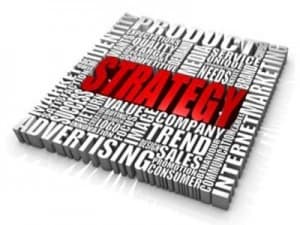 In the first two parts of this series, we looked at the current innovation paradigm. That paradigm consists mostly of two primary approaches: namely incremental innovation that looks more like continuous improvement, and a free-for-all that is more like chaos. We also looked at a third approach to innovation: leveraging existing marketing infrastructure to produce a future state narrative. That narrative acts as a future state blueprint for product or service development to move toward.
In the first two parts of this series, we looked at the current innovation paradigm. That paradigm consists mostly of two primary approaches: namely incremental innovation that looks more like continuous improvement, and a free-for-all that is more like chaos. We also looked at a third approach to innovation: leveraging existing marketing infrastructure to produce a future state narrative. That narrative acts as a future state blueprint for product or service development to move toward.
Innovation Begins with Customer Collaboration
Customer collaboration is more than surveys, polls, focus groups, or social media input. Even though these components can all be part of a collaboration strategy, you also need customer dialog and customer engagement. Outlets such as Twitter, Facebook, or forums create a dialog, but if a company is not ready to hear the truth about their products, they may be in for a shock. For example, see the second half of the following post under the section entitled “A Technology Change that will Force You to Work More Closely with Customers.“
All companies should consider adding an open forum to their application portfolios. This external forum is the first real bridge to customer integration. Full collaboration integration into ERP applications is possible when you take a focused approach to how the application is used (SAP, ERP III, SOA — Learning Organizations through Social Media Collaboration). Properly deployed collaboration tools do not need to be expensive, complicated, or difficult– rather, they can transform organizations (ERP III – Is the Integration of Collaboration the Future of Enterprise Applications).
SAP has successfully created a pair of portals that integrate customers, consultants, and vendors into the process and product development through its customer ASUG (Americas SAP User Group), SCN (SAP Collaboration Network), and their partner Eco System (vendor participation). These are all tremendous examples of how SAP as a company is integrating meaningful social media tools and collaboration initiatives fully into the Enterprise.
Just how successful is this?
Although media outlets made a huge issue out of the ASUG-based rebellion of the customer base over SAP’s proposed maintenance fee increase, it is a testament to the importance and power of collaboration with end customers. Although SAP may have considered the backlash over maintenance fees a failure, this backlash should be considered instead as satisfying customer expectations. After all, the global economy has been struggling, competitors such as Rimini Street have targeted application support, and customers have long questioned what they get for the support. A successful press to increase maintenance fees would have likely led to wholesale defections of customers to Rimini Street and would have created a massive market opportunity for other support vendors. The mass defection to support vendors such as Rimini Street could have easily cost far more than just the lost maintenance fees– it could have cost significant upgrade revenues as well.
What Can You Do to Create Customer-Focused Innovation?
To start, you should glean a measure of customer intelligence to understand their frustrations with the current marketplace and their desires (Business Strategy and IT Strategy to Reproduce Apple Innovation). A forum or other discussion mechanism freely available to customers for feedback is a good place to start. Company managers and employees should be required to participate in those forum discussions so you can gain greater insight into the customer perspective, including their frustrations, desires, and concerns.
From that exchange many of the customer drivers can be derived to begin assembling the innovation narrative around new products or services, or around significant improvements to existing products or services.
The thing to remember here is that you don’t have to create the “miracle” product or service. You don’t even need to create the product or service that meets the ideal state. You only need a product or service that is noticeably better and different from your competitors. Within the framework of the narrative, you can continue to move your products ahead by making them more and more like the ideal state narrative over time.
Great Employees Make for Great Customer Experience
Facebook as an Inexpensive Marketing Outlet and Employee Recruiting Tool
Facebook may work well as an inexpensive marketing channel for promotions and offers. Properly constructed, you can encourage an extended customer base to visit Facebook for new offers or promotions. However, I personally see a different application for Facebook in particular. I believe the application is best served as an employee recruiting tool.
Tools such as Facebook have a legitimate place in the enterprise. Even though a recent Harvard Business Review case study demonstrated that their use for businesses with huge customer bases is limited (Social Media Fads and the Risk to the Enterprise), these tools work well if properly connected to a specific business purpose. Toward that end, Facebook in particular can generate a group of loyal customers who might make the best pool of potential employees to recruit from.
What the Harvard study showed was that Facebook was most likely to attract those who are already fans. And who would make the best employees of your company? True fans as employees are far more likely to be satisfied and produce a good customer experience. They are also much more likely to defend the brand and to actively engage in meaningful dialog with customers to understand where there might be opportunities for innovation.
Conclusion
I have provided a few examples and a starting place for a framework for customer focused innovation. As I previously laid out in a post entitled “From Collaboration to Innovation to Market – Toward a Working Model,” you can take a rational approach to innovation in the enterprise:
Conceive
- Collaborate (technology integration)
- Gather intelligence and research
- Ideas (customer immersion narrative)
- Socialize (customers, employees, other stakeholders)
Develop
- Prioritize (emerging trend or fad)
- Prototype (mock-ups, story boards, paper prototypes, actual working models)
- Pilot (finalize design, costing, materials or talent, etc.)
Market
- Market trial
- Refinement
- Sales Campaign
This collection of posts has been an initial attempt to bring a starting framework to an area that has little guidance and little academic research. The whole area of innovation seems to be a black box to most. This has been a bit more of a challenge than I had originally expected, and I expect that as I continue to toy with these ideas and approaches, that something more concise will eventually emerge. To that end, I would be curious about your feedback and input on the material.





